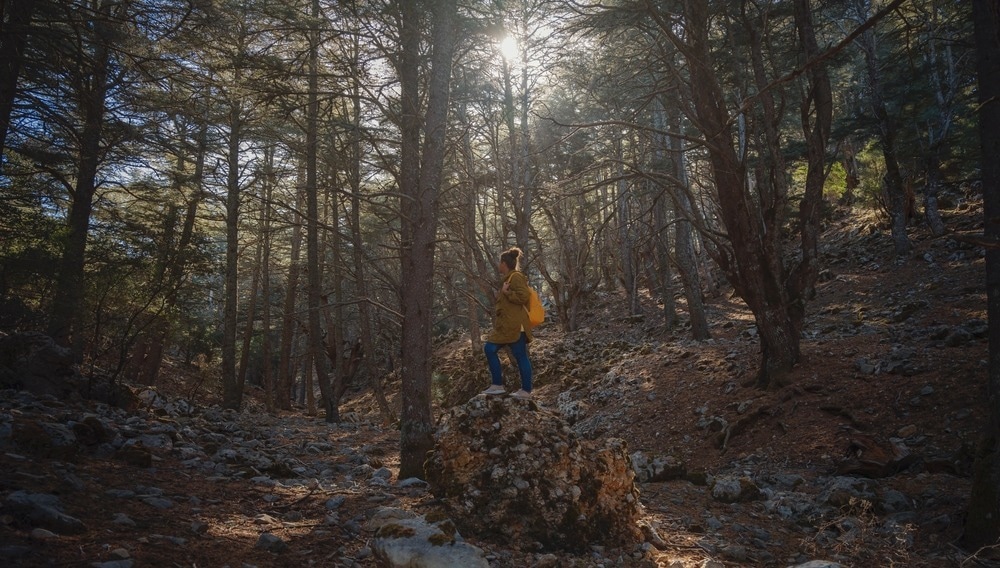Friluftsliv: The Norwegian Prescription for Health and Happiness
Understanding friluftsliv
Friluftsliv and health
Happiness and connection to nature
Friluftsliv as a global phenomenon
Conclusion
References
Further reading
Friluftsliv is a Scandinavian philosophy highlighting the emotional significance and health benefits of being immersed in nature. It is a cultural practice with Norwegian roots, although the concept is also present across several other Nordic cultures, with some variations between each of them.

Image Credit: U__Photo/Shutterstock.com
Spending time in nature has a large number of health and wellbeing benefits, from reports of higher levels of the subjective experience of cognitive restoration to increased vitamin D levels, which in turn improves physical and mental health outcomes. These findings have been established across a large number of different cultural and non-cultural practices, including friluftsliv.
Understanding friluftsliv
The earliest records of friluftsliv appear to come from the work of Norwegian playwright and poet Henrik Ibsen. The concept appears a number of times throughout his work during the 1800s. Since then, the practice has become established across both Norway and Sweden, in addition to other Scandinavian countries.
Scholars have interpreted Friluftsliv as the experience of interacting with the natural environment. Specifically, it seems that deriving pleasure from engaging with nature alone – without being distracted by another activity, such as sports – is true friluftsliv. However, modern applications of the practice involve spending intentional time in nature across all contexts.
Some argue that the shift in focus of friluftsliv creates a more superficial perspective of the practice. This view suggests that friluftsliv requires a deep, spiritual connection to be made with nature: one that perhaps cannot be established via a brief stroll or a game of outdoor sports. While this may be the case, there are still a large number of health and wellbeing benefits to be gained from these activities also.
Friluftsliv and health
Interacting with nature is associated with better health across several areas, including lowered blood pressure, decreased heart rate variability, and increased levels of vitamin D. In general, light exercise and other recreational activities can also offer a range of health benefits in some populations, and so any time spent partaking in exercise outdoors can also improve health outcomes.
A meta-analysis was conducted by the University of Copenhagen and the Steno Diabetes Center Copenhagen, investigating the use of immersive nature experiences as health intervention and promotion tools. The analysis particularly focused on the friluftsliv perspective, although other nature-based practices and experiences were also considered, creating an intercultural perspective.
The study returned mixed findings across several aspects of mental, physical, and social health. Findings regarding physical health were particularly mixed, but psychophysiological measures of stress garnered slightly more positive results. For instance, heart rate variability, cortisol levels, and other stress indicators frequently decreased with short-term experiences of nature-based relaxation.
It has been noted that there is a lack of high-quality research into friluftsliv’s specific impact on health. Some findings are instead generalized from the benefits of other kinds of outdoor recreation, exercise, and natural connectedness. So they may not be fully and truly representative of the outcomes of the practice itself.
Happiness and connection to nature
Environmental connectedness is a psychological concept establishing the relationship between humans and nature. This relationship can be measured through several different factors, including sensitivity, cognitive processing, and biophilia, the philosophy that humans are innately driven to interact with other living things and nature more broadly.
A correlational study was conducted using data from the Swedish Outdoor Recreation in Change national survey to find that there was a statistically significant relationship between environmental connectedness and participation in friluftsliv activities. These findings were the same even when other relevant predictor variables were controlled for, demonstrating a highly ‘meaningful’ relationship.
The relationship between environmental connectedness and happiness has also been studied extensively. A meta-analysis with collectively more than 8,500 participants found that individuals who were more environmentally connected also appeared to experience higher levels of life satisfaction and positive affect than those who were less connected to the environment.
The strongest positive relationship found in the analysis was between experiences of happiness and ‘inclusion of nature in self.’ This is a specific aspect of environmental connectedness that was developed in 2001, operationalizing how much somebody involves nature when representing themselves cognitively, therefore creating mental proximity between themselves and nature as a concept.
Friluftsliv as a global phenomenon
Awareness of friluftsliv is spreading interculturally, with the practice being explored in both research and practical contexts. The practice is present across several Scandinavian cultures, with much of the literature representing Swedish practices of Friluftsliv. Currently, the practice is also represented in popular culture throughout the United Kingdom.
Other nature-based practices are also found across a number of non-Nordic cultures. For example, forest bathing is the Japanese practice of meditating in nature, while ecotherapy is a growing field in several countries. Many Indigenous cultures also center on the importance of experiencing a connection with nature.
Adventure and nature tourism can also be informed by friluftsliv, giving a taste of the philosophy to travelers. Research suggests that an expedition across the Svalbard glaciers was enhanced when the ideals of friluftsliv were embedded into the guidance given throughout the trip. Specifically, the trip offered greater educational opportunities, as well as offering tourists the chance to connect with nature.
Conclusion
Friluftsliv is a philosophy and practice that can offer enrichment and the opportunity to connect with nature. As such, it could offer benefits for both mental and physical health – or perhaps specifically, the intersection between the two.
As with any cultural practice, friluftsliv has particular nuances and elements that ought to be learned in order to practice it properly. However, time spent outdoors in a wide range of forms has the chance of offering rewards to health and wellbeing, particularly when the practice is adapted to the individual’s needs.
There is scope for further research to be conducted into the specific practice of friluftsliv and its effects. Although the literature offers the general perspective that nature has positive outcomes for health, wellbeing, and happiness, few studies are specifically conducted into the practice of friluftsliv itself. Because of this, the nuances and particularities of friluftsliv may be missed as a variable in the research.
References
- Gelter, H. (2000). Friluftsliv: The Scandinavian philosophy of outdoor life. Canadian Journal of Environmental Education (CJEE), 77-92.
- Elgvin, D. T. (2009). Henrik Ibsen’s use of ‘Friluftsliv’. Stjørdal: North Trøndelag University College.
- Pasanen, T., Johnson, K., Lee, K., & Korpela, K. (2018). Can nature walks with psychological tasks improve mood, self-reported restoration, and sustained attention? Results from two experimental field studies. Frontiers in Psychology, 9, 2057.
- Pan, C. W., Qian, D. J., & Saw, S. M. (2017). Time outdoors, blood vitamin D status and myopia: a review. Photochemical & Photobiological Sciences, 16, 426-432.
- Beery, T. H., & Wolf-Watz, D. (2014). Nature to place: Rethinking the environmental connectedness perspective. Journal of Environmental Psychology, 40, 198-205.
- Grinde, B., & Patil, G. G. (2009). Biophilia: does visual contact with nature impact on health and wellbeing?. International journal of environmental research and public health, 6(9), 2332-2343.
- Capaldi, C. A., Dopko, R. L., & Zelenski, J. M. (2014). The relationship between nature connectedness and happiness: A meta-analysis. Frontiers in psychology, 976.
- Horiuchi, M., Endo, J., Akatsuka, S., Hasegawa, T., Yamamoto, E., Uno, T., & Kikuchi, S. (2015). An effective strategy to reduce blood pressure after forest walking in middle-aged and aged people. Journal of Physical Therapy Science, 27(12), 3711-3716.
- de Brito, J. N., Pope, Z. C., Mitchell, N. R., Schneider, I. E., Larson, J. M., Horton, T. H., & Pereira, M. A. (2020). The effect of green walking on heart rate variability: A pilot crossover study. Environmental research, 185, 109408.
- Twohig-Bennett, C., & Jones, A. (2018). The health benefits of the great outdoors: A systematic review and meta-analysis of greenspace exposure and health outcomes. Environmental research, 166, 628-637.
- Trangsrud, L. K., Borg, M., & Bratland-Sanda, S. (2020). Friluftsliv in eating disorder recovery: a systematic review. Journal of Outdoor Recreation, Education, and Leadership, 12(2).
- Mygind, L., Kjeldsted, E., Hartmeyer, R. D., Mygind, E., Bølling, M., & Bentsen, P. (2019). Immersive nature-experiences as health promotion interventions for healthy, vulnerable, and sick populations? A systematic review and appraisal of controlled studies. Frontiers in psychology, 943.
- Keaulana, S., Kahili-Heede, M., Riley, L., Park, M. L. N., Makua, K. L., Vegas, J. K., & Antonio, M. C. (2021). A scoping review of nature, land, and environmental connectedness and relatedness. International Journal of Environmental Research and Public Health, 18(11), 5897.
- Brondízio, E. S., Aumeeruddy-Thomas, Y., Bates, P., Carino, J., Fernández-Llamazares, Á., Ferrari, M. F., … & Shrestha, U. B. (2021). Locally based, regionally manifested, and globally relevant: Indigenous and local knowledge, values, and practices for nature. Annual Review of Environment and Resources, 46, 481-509.
- Andersen, S., & Rolland, C. G. (2018). Educated in friluftsliv–working in tourism: A study exploring principles of friluftsliv in nature guiding. Scandinavian Journal of Hospitality and Tourism, 18(4), 362-376.
Further Reading
- All Mental Health Content
- World mental health support and the effect of stigma and discrimination
- A Guide to Coping with Change
- Managing and Reducing Stress
- Analyzing the Stigma Surrounding Mental Health
Last Updated: Nov 9, 2023





